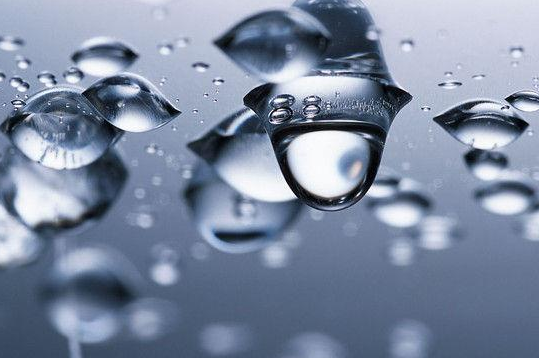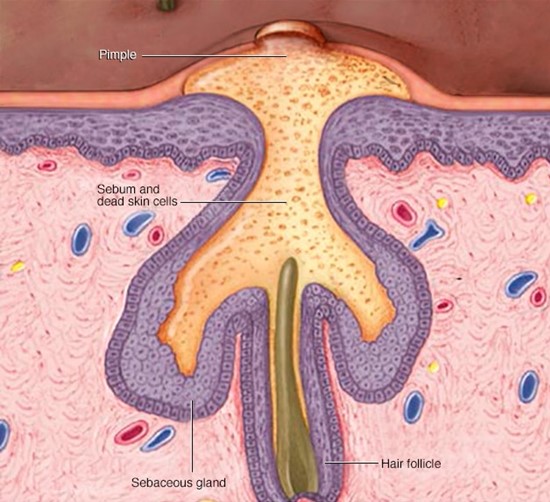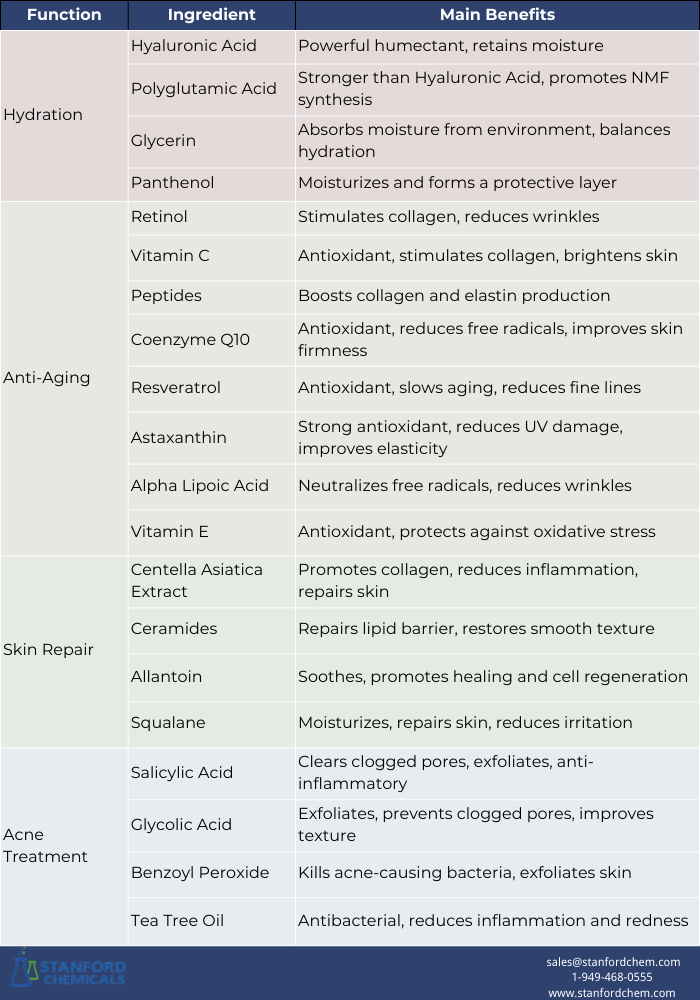Common Skin Care Ingredients You Need to Know
Skincare products are a big reference when you are choosing which product to buy. For instance, if you want to treat acne, then knowing which ingredients prove to be effective in such cases will definitely help you pick up the right one. But I’m sure you’re not the only one who’s confused by the myriad ingredients in skincare products. Therefore, the purpose of this article is to help understand the functons associated with the most common skincare ingredients.
1. Hydration and Moisture Retention
Whether your skin is dry, oily, or a mix of both, moisturizing has proven to be an unavoidable routine in skincare. Hydration is also essential for skin barrier integrity. Below are some of the most popular common moisturizing ingredients available in the market.
Fig 1. Moisturizing is the first step in skin care
(1)Hyaluronic Acid
Hyaluronic acid has been basking in skincare fame for over 30 years because of the mighty skincare benefits it possesses. Being an excellent humectant, it can absorb and retain many times-more than 1,000 times its weight in water. Besides that, it forms a defensive layer on the skin surface which protects water from evaporating too fast.
(2)Polyglutamic Acid
For those looking for an alternative to hyaluronic acid, polyglutamic acid is an excellent choice. It can capture more moisture than hyaluronic acid, twice as much. It penetrates deeper into the skin, stimulating natural moisturizing factors. Another big plus is that this product has low viscosity, contributing to less stickiness and freshness in the skin.
(3)Glycerin
Glycerin is an active humectant that attracts moisture from the surroundings and locks it in the skin to help maintain the moisture balance of the skin. This prevents dryness and dehydration, hence it maintains soft and smooth skin. It also enhances the absorption of active skincare ingredients.
(4)Panthenol
Also known as vitamin B5, panthenol is an active moisturizer that attracts and retains water in the skin and forms a protective layer on the skin’s surface to prevent water loss.
2. Anti-Aging and Anti-Wrinkle
With growing age, skin slowly starts to lose its elasticity and firmness. Collagen and elastin production decelerates, which eventually leads to fine lines and wrinkles. Moreover, UV rays, pollution, and stress accelerate the aging process of the skin. Anti-aging and anti-wrinkle ingredients improve not only one’s appearance but also care for the health of the skin by minimizing possible external damage.
Fig 2. Anti-wrinkle makes us look younger
(1)Retinol
Retinol is probably the star of the anti-aging world. Such an ingredient increases the production of collagen within the skin, which will help reduce fine lines and wrinkles. Moreover, such a vitamin accelerates cell turnover, promoting new skin cell generation. The process will improve the skin texture and tone by getting rid of dark blemishes.
(2)Vitamin C
Vitamin C is an antioxidant with great power that neutralizes free radicals, protecting the skin from environmental damage such as UV rays. It enhances the production of collagen, which in turn gives skin elasticity, hence reducing fine lines. Vitamin C further brightens the skin, reducing pigmentation and helping the skin have a more youthful look.
(3)Peptides
Peptides are small protein fragments that easily penetrate the skin, stimulating collagen and elastin production. The peptides will strengthen the structure of the skin; fine lines and wrinkles are reduced effectively, and firmness and elasticity are enhanced. Besides, it enhances the skin barrier function and generally increases the health of the skin while making it fuller.
(4)Coenzyme Q10
Coenzyme Q10 is a powerful antioxidant that shields skin cells from free radical damage, thereby providing a considerable reduction in the appearance of environmental stressors that contribute to aging. It boosts the energy at a cellular level by increasing the manufacture of ATP, enhancing the repair and regeneration of cells, thereby reducing fine lines and wrinkles, or at least diminishing their appearance. The skin turgor will also be much improved.
(5)Resveratrol
Resveratrol is an antioxidant plant extract that has an excellent anti-aging effect. It scavenges the free radicals, thus avoiding skin damage from oxidative stress and inflammation, which contributes to early aging. Continuous use of resveratrol diminishes the appearance of fine lines while improving skin smoothness and firmness.
(6)Astaxanthin
Astaxanthin is an astoundingly strong natural antioxidant, way more powerful than vitamin C and vitamin E. It significantly reduces UV damage, preventing photoaging. By improving skin hydration, it improves elasticity and reduces wrinkles, thus leaving the skin smoother.
(7)Alpha Lipoic Acid
Alpha lipoic acid is an effective antioxidant; besides neutralizing free radicals, it regenerates other antioxidants such as vitamin C and vitamin E, hence enhancing the anti-aging effect by increasing the density. It minimizes inflammation, fine lines, and wrinkles, hence enhancing skin tone and brightness.
(8)Vitamin E
It is a classic antioxidant that helps protect the skin from oxidative stress while delaying the aging process. Vitamin E helps to repair broken skin cells and firm up the skin barrier, reducing occurrences of fine lines and wrinkles.
Read more: Hyaluronic Acid vs. Retinol vs. Vitamin C: Which Is Best for Skincare?
3. Skin Repair
When the skin barrier is compromised, it will release moisture more easily and become exposed to more external irritants. This generally means more inflammation and dry sensitivity. Hence, skin repair is another important step of skin care.
Fig 3. Repair skin damage and make skin healthier
(1)Centella Asiatica Extract
Centella Asiatica is one of the major ingredients in skin repair. It contains various components like asiaticoside-the major phenolic compound responsible for scar healing. Centella Asiatica enhances the production of collagen and reduces inflammation by regenerating and improving skin elasticity of the destroyed skin barrier.
(2)Ceramides
Ceramides are natural constituents of the skin barrier. They repair damaged lipid barriers, reducing skin irritations due to dryness. The ceramides help your skin protect against external irritants and pollutants-softening the skin and making it supple.
(3)Allantoin
Allantoin is an active repairing ingredient well known for its soothing action, as well as cell regeneration. It soothes itching, redness, and roughness occurring due to dryness while allowing the stimulation of the healing process and thus leaving the skin smooth and soft.
(4)Squalane
It is an emollient agent, just like the skin’s natural oils. Squalane improves the barrier integrity of skin, restores dry and injured skin, and exerts antioxidant and anti-inflammatory effects, thus decreasing skin irritation.
Among the above ingredients, hyaluronic acid and panthenol have prominent skin-repairing properties. Hyaluronic acid especially accelerates wound healing.
4. Acne Treatment
Acne is one of the fundamental skin problems brought about by blockage of pores, production of excess oil, and infection. Treatment of acne also enables you to maintain healthy skin.
Fig 4. Causes of acne: clogged pores, excess oil production, and infection
(1)Salicylic Acid
Salicylic acid is a beta hydroxy acid; it is also lipid-soluble, which allows it to penetrate into the pores and dissolve excess oil and dead skin cells that block pores in the first instance. This helps reduce and prevent acne, while it also gently exfoliates the surface of the skin to improve the rough texture associated with acne. Its anti-inflammatory properties further help reduce redness and swelling associated with acne.
(2)Glycolic Acid
Glycolic acid is an AHA, which accelerates cell turnover, removing the superficial layer of dead skin cells, thus avoiding clogged pores and acne breakouts. It also improves post-acne pigmentation and scarring by improving skin texture and evening out the skin.
(3)Benzoyl Peroxide
The active ingredient benzoyl peroxide is a very potent anti-acne ingredient that truly delivers deep into the pores and kills acne-causing bacteria, such as Propionibacterium acnes. It also exfoliates the skin, removing dead skin cells and oil within the pores, which helps them not to get blocked and, therefore, prevents new acne.
(4)Tea Tree Oil
Tea tree oil is a natural ingredient incorporating antibacterial and anti-inflammatory properties into its effectiveness in battling acne-causing bacteria and reducing inflammation and redness. Gentle on the skin, it provides antibacterial action that helps purify the skin and decreases bacterial build-up inside the pores.
Conclusion
Being aware of the various benefits of different skincare ingredients will enable you to know exactly which products to choose based on specific needs. Understanding what ingredients suit your skin type and needs better enables you to tailor an effective skincare routine that resolves any hydration concerns, anti-aging, repair, or treatment of acne for healthier and more radiant-looking skin.
Stanford Chemicals Company (SCC) has over 16 years of experience in the manufacture and sale of skin care and personal care ingredients. We offer skin care ingredient raw materials to meet a variety of skin care needs.
Table 1. List of Common Skincare Ingredients





